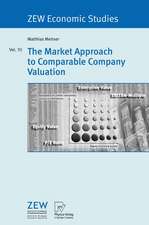Money Stock Control and Inflation Targeting in Germany: A State Space Modelling Approach to the Bundesbank’s Operating Procedures and Intermediate Strategy: Contributions to Economics
Autor Claus Branden Limba Engleză Paperback – 27 mar 2001
Din seria Contributions to Economics
- 18%
 Preț: 1001.81 lei
Preț: 1001.81 lei -
 Preț: 90.83 lei
Preț: 90.83 lei - 15%
 Preț: 649.06 lei
Preț: 649.06 lei - 18%
 Preț: 1109.92 lei
Preț: 1109.92 lei - 24%
 Preț: 657.06 lei
Preț: 657.06 lei - 18%
 Preț: 976.54 lei
Preț: 976.54 lei - 17%
 Preț: 361.01 lei
Preț: 361.01 lei - 18%
 Preț: 1027.83 lei
Preț: 1027.83 lei -
 Preț: 283.93 lei
Preț: 283.93 lei - 15%
 Preț: 644.95 lei
Preț: 644.95 lei - 15%
 Preț: 638.24 lei
Preț: 638.24 lei -
 Preț: 394.29 lei
Preț: 394.29 lei - 15%
 Preț: 636.80 lei
Preț: 636.80 lei - 15%
 Preț: 637.78 lei
Preț: 637.78 lei - 18%
 Preț: 723.69 lei
Preț: 723.69 lei - 15%
 Preț: 635.47 lei
Preț: 635.47 lei - 15%
 Preț: 634.00 lei
Preț: 634.00 lei -
 Preț: 392.75 lei
Preț: 392.75 lei -
 Preț: 383.33 lei
Preț: 383.33 lei - 15%
 Preț: 637.28 lei
Preț: 637.28 lei - 15%
 Preț: 636.80 lei
Preț: 636.80 lei - 18%
 Preț: 950.96 lei
Preț: 950.96 lei - 15%
 Preț: 634.68 lei
Preț: 634.68 lei -
 Preț: 387.38 lei
Preț: 387.38 lei - 15%
 Preț: 647.27 lei
Preț: 647.27 lei - 15%
 Preț: 636.63 lei
Preț: 636.63 lei - 15%
 Preț: 639.73 lei
Preț: 639.73 lei -
 Preț: 385.62 lei
Preț: 385.62 lei - 15%
 Preț: 641.85 lei
Preț: 641.85 lei - 20%
 Preț: 649.60 lei
Preț: 649.60 lei - 15%
 Preț: 641.71 lei
Preț: 641.71 lei -
 Preț: 387.96 lei
Preț: 387.96 lei - 15%
 Preț: 645.47 lei
Preț: 645.47 lei -
 Preț: 385.08 lei
Preț: 385.08 lei - 15%
 Preț: 646.62 lei
Preț: 646.62 lei -
 Preț: 383.33 lei
Preț: 383.33 lei - 15%
 Preț: 638.43 lei
Preț: 638.43 lei -
 Preț: 381.21 lei
Preț: 381.21 lei - 15%
 Preț: 642.51 lei
Preț: 642.51 lei - 15%
 Preț: 637.78 lei
Preț: 637.78 lei - 15%
 Preț: 641.71 lei
Preț: 641.71 lei -
 Preț: 384.70 lei
Preț: 384.70 lei -
 Preț: 379.86 lei
Preț: 379.86 lei -
 Preț: 378.34 lei
Preț: 378.34 lei -
 Preț: 384.70 lei
Preț: 384.70 lei -
 Preț: 388.52 lei
Preț: 388.52 lei - 15%
 Preț: 641.71 lei
Preț: 641.71 lei -
 Preț: 381.00 lei
Preț: 381.00 lei - 15%
 Preț: 644.95 lei
Preț: 644.95 lei -
 Preț: 386.00 lei
Preț: 386.00 lei
Preț: 381.98 lei
Nou
Puncte Express: 573
Preț estimativ în valută:
73.09€ • 76.52$ • 60.48£
73.09€ • 76.52$ • 60.48£
Carte tipărită la comandă
Livrare economică 07-21 aprilie
Preluare comenzi: 021 569.72.76
Specificații
ISBN-13: 9783790813937
ISBN-10: 3790813931
Pagini: 188
Ilustrații: XII, 174 p.
Dimensiuni: 155 x 233 x 10 mm
Greutate: 0.27 kg
Ediția:Softcover reprint of the original 1st ed. 2001
Editura: Physica-Verlag HD
Colecția Physica
Seria Contributions to Economics
Locul publicării:Heidelberg, Germany
ISBN-10: 3790813931
Pagini: 188
Ilustrații: XII, 174 p.
Dimensiuni: 155 x 233 x 10 mm
Greutate: 0.27 kg
Ediția:Softcover reprint of the original 1st ed. 2001
Editura: Physica-Verlag HD
Colecția Physica
Seria Contributions to Economics
Locul publicării:Heidelberg, Germany
Public țintă
ResearchCuprins
1. Introduction.- 1.1 Intermediate strategies for monetary policy.- 1.2 The role of the Bundesbank.- 1.3 The methodological framework.- 2. Measuring monetary policy: Operating procedures and intermediate strategies.- 2.1 The conduct of monetary policy in Germany.- 2.2 Operating procedures and money supply.- 2.3 A note on the identifiability of money demand.- 2.4 A note on the identifiability of autonomous monetary policy actions.- 2.5 Evidence from recent empirical analyses of German monetary policy.- 3. Theoretical framework.- 3.1 Basic considerations.- 3.2 Interest rate operating procedure (from 1985 on).- 3.3 An alternative approach: reserves targeting.- 3.4 Discount window borrowing procedure (1975–1984).- 3.5 Concluding remarks.- 4. Analysis of time series using linear state space models.- 4.1 Basic concepts.- 4.2 The linear state space model.- 4.3 Specific properties of the linear model.- 4.4 Signal extraction using the Kalman filter.- 4.5 Structural analysis.- 4.6 Model selection and estimation.- 4.7 Modelling nonstationary time series and common stochastic trends.- 5. Empirical implementation and results.- 5.1 Is a multiplier approach adequate to model German money supply?.- 5.2 Monetary targeting and the business cycle.- 5.3 A quantity theory based approach to inflation targeting.- 6. Conclusions.- 6.1 Methodological remarks.- 6.2 Money stock control and the day—to—day conduct of monetary policy.- 6.3 Money stock control and inflation targeting in Germany.- 6.4 Prospects for the ECB’s monetary policy strategy.- List of figures.- List of tables.- A. GAUSS—programs.- A.1 Estimation of balanced state space model.- A.2 Obtaining in—sample forecasts using the Kalman filter.- A.3 Calculation of impulse—responses.- A.4 Calculation of forecast—errorvariance decompositions.- A.6 Aoki C-Test for model specification.
Textul de pe ultima copertă
The book considers issues relevant to the European Central Bank in refining and communicating its strategy. It offers a historical assessment of the Bundesbank's strategy of monetary targeting conducted from 1974 to 1998. In contrast to several other prominent studies it is argued that money played a flexible but very important role in the conduct of its policy. It also explores the implications of the identified monetary policy regime in the context of various theories of the money supply process.
The empirical analysis conducted in this study is based on a linear state space modelling approach which offers an appealing and direct representation of common stochastic trends. The framework is less restrictive and it is encompassing in that it does not construe the persistent dynamics as being driven by pure random walk components.
The empirical analysis conducted in this study is based on a linear state space modelling approach which offers an appealing and direct representation of common stochastic trends. The framework is less restrictive and it is encompassing in that it does not construe the persistent dynamics as being driven by pure random walk components.
Caracteristici
Includes supplementary material: sn.pub/extras








